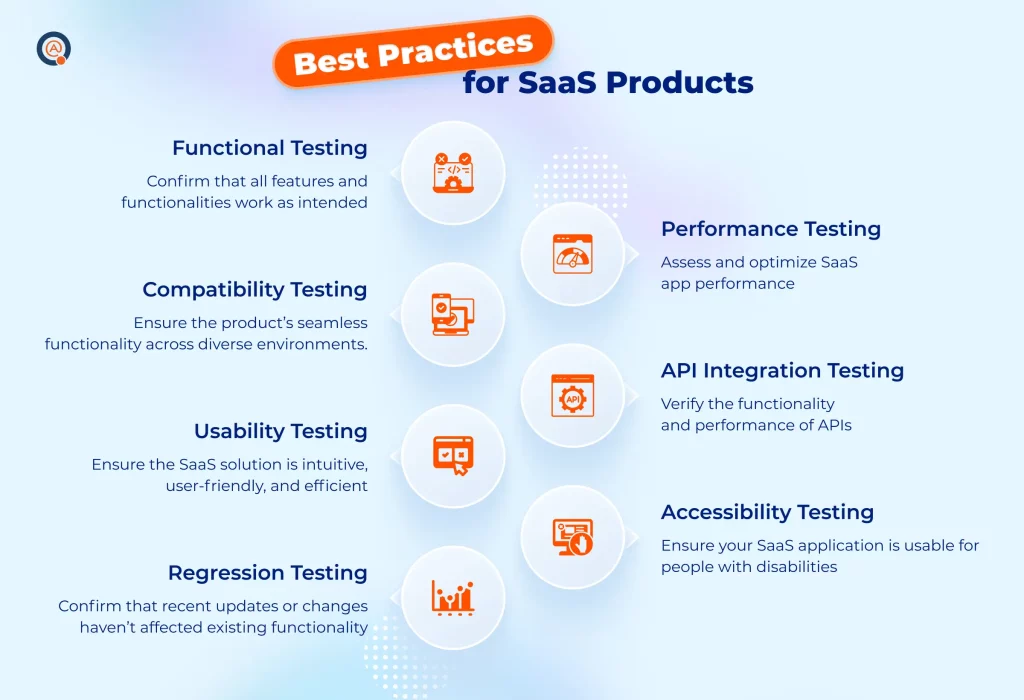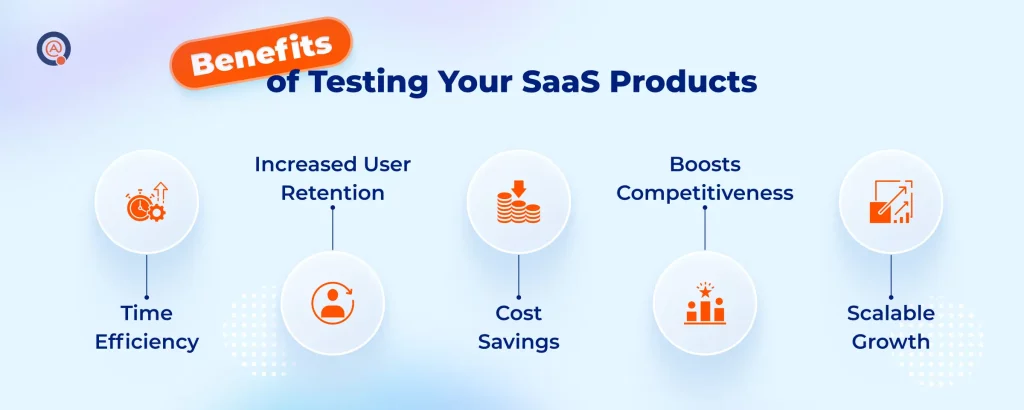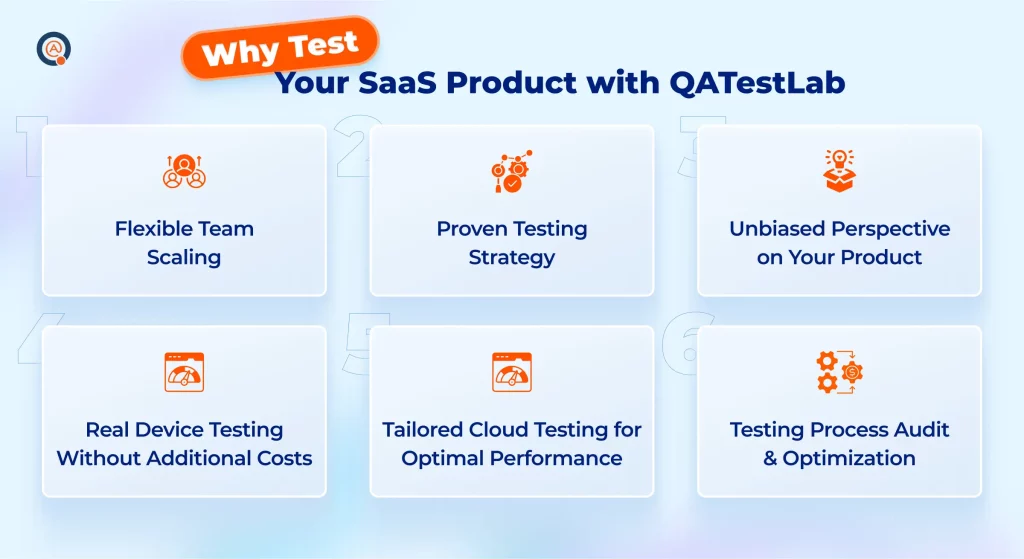The Secret of Effective SaaS Testing: Best Practices for Checking Cloud-Based Products
by Tetyana Lykhitska | April 15, 2025 11:44 am
SaaS testing is essential to ensure your product is free from bugs, glitches, and usability issues that could negatively impact the user experience and damage your brand’s reputation. Without thorough checking, your product could fail to meet customer expectations. This can result in reduced conversions, lost revenue, subscriber attrition, and lost business opportunities.
SaaS testing comes with its own unique set of challenges due to the distinct characteristics of cloud-based solutions. That’s why quality assurance requires a specialized approach to ensure your product’s high quality and performance.
In this article, we will explore the key challenges of SaaS testing and best practices for overcoming them. Let’s find out the secrets to successfully testing cloud-based solutions.
SaaS Software Challenges that Can Be Resolved by Testing
Keeping Up with the Pace of Continuous Updates
Challenge: SaaS products are updated frequently, requiring all teams to operate at a consistently high pace. Under heavy workloads, there’s often not enough time to thoroughly validate each release, increasing the risk of bugs reaching production and affecting users.
Solution: We help overcome this challenge by supporting your in-house QA team, taking over the testing workload, and ensuring updates are properly validated before going live.
Delivering a Consistent Experience Across Devices and Browsers
Challenge: Users interact with SaaS applications across various devices, OS, and browsers, making it challenging to ensure a seamless and consistent product experience in every environment. Inconsistent behavior across platforms not only frustrates users but can also damage your credibility and lead to churn.
Solution: Cross-platform SaaS testing helps ensure customers can use your product, regardless of the device or platform they use.
Avoiding Bottlenecks in Release Cycle
Challenge: Every new version of your SaaS product must be tested before release – otherwise, updates can cause system failures or prolonged downtime. However, hiring, onboarding, and managing in-house testers takes time, effort, and significant investment. This affects the speed and efficiency of your release cycle.
Solution: We’re ready to integrate into your workflow at any stage. No hiring, onboarding, or training is required — just ready-to-go QA specialists who can quickly cover the full scope of testing tasks, help you move fast, and release with confidence.
Eliminating Product Failures Caused by Third-Party Service Changes
Challenge: SaaS products rely on third-party services that can change independently. This often leads to unexpected functional failures, broken critical business processes like payments or authentication, and issues that can be noticed only after users are affected. As a result, clients lose trust, and your product’s reputation suffers.
Solution: Integration SaaS testing helps to catch issues arising from changes to third-party services before release – ensuring key flows such as payments or logins work as expected. After launch, automated regression testing that runs regularly in production helps you quickly identify and fix any new integration issues – before users even notice.
Preventing Critical Risks in Multi-Tenant Environments
Challenge: SaaS applications often use a multi-tenant architecture, where a single system serves many customers at once. Testing such an environment requires specific skills and experience. Without a clear understanding of data isolation risks, access control settings, and edge-case scenarios, it’s easy to miss critical issues — like one client accidentally seeing another’s data. These mistakes can result in loss of customer trust, legal and compliance risks, and long-term damage to your reputation.
Solution: Our QA engineers have the experience and skills required to test complex multi-tenant environments properly, helping you prevent costly errors and maintain customer trust.
Handling Traffic Spikes Without System Failures
Challenge: To ensure stability, your SaaS product needs to be ready for sudden spikes in traffic. Without proper preparation, a rapid increase in load can crash the system. Since most SaaS platforms use multi-tenant architecture, one failure can impact all clients. Over time, it affects customer satisfaction and puts your reputation at risk.
Solution: Load and performance testing help identify weak points before they cause real issues – so your platform stays fast, stable, and scalable for every customer.
Avoiding Delays Caused by Time-Consuming Regression Checks
Challenge: In multi-client SaaS systems, a single update may require verifying each client instance separately. This creates the need for constant regression testing to ensure stability across all environments, which is time-consuming.
Solution: We’ll take on regression SaaS testing for you and help scale repetitive checks efficiently — freeing up your resources and enabling faster releases without compromising quality.
Best Practices for SaaS Testing

Functional Testing
Functional testing[1] verifies whether products meet functional requirements without defects. This type of checking allows you to ensure that all the features and functionalities work exactly as intended, according to their design specifications. Here’s what to focus on during functional SaaS testing:
- Core Functionality Validation – Ensuring that all essential features operate flawlessly and deliver the intended value to users.
- User Workflow Testing – Identifying roadblocks or inconsistencies that may disrupt task completion, ensuring users can navigate the application without confusion or frustration.
- Error Handling & Feedback – Verifying that error messages are clear and helpful, guiding users toward solutions while minimizing frustration.
Performance Testing
Performance testing[2] verifies whether the system is able to withstand high loads of different volumes, duration, and velocity of change based on its technical requirements. Proactively assessing and optimizing performance enhances user engagement, retention, and loyalty, driving business growth and success in the competitive marketplace. This type of testing entails:
- Load Testing – Evaluating a SaaS application’s ability to handle varying loads. By applying high loads, QA teams can determine the system’s maximum capability and identify performance bottlenecks to ensure a seamless user experience.
- Stress Testing – Measuring how the application responds under extreme conditions, including those exceeding normal operational expectations. This helps prevent slowdowns, crashes, and service disruptions.
- Multi-User Testing – Evaluating how the application behaves when multiple users interact with it at the same time. By simulating concurrent user actions, QA teams can verify that the system maintains consistent performance, handles shared resources properly, and prevents data conflicts.
Compatibility Testing
Compatibility testing[3] ensures seamless product functionality across diverse environments. Proactive testing enhances user satisfaction, reduces support needs, and protects your brand’s reputation by preventing functionality and layout issues. Testing for compatibility includes:
- Operating System Compatibility – Ensuring smooth performance on Windows, macOS, iOS, Android, Linux, and various OS versions.
- Multi-Device Testing – Verifying app performance across various devices with different screen sizes, resolutions, cameras, input types, and sensors to ensure a consistent and reliable user experience.
- Cross-Browser Testing – Ensuring consistent performance across different browsers (Chrome, Safari, Firefox, Edge, etc.) and their versions, validating UI rendering, interactive elements, and platform responsiveness.
API Integration Testing
API integration testing[4] verifies the functionality and performance of application programming interfaces (APIs) to ensure smooth integration and interoperability with other systems. It is crucial for SaaS providers as it ensures that their APIs operate effectively with their customers’ systems. Our approach involves:
- Functional API Testing – Checking whether each API component works as expected. This ensures endpoints process inputs correctly and return the expected outputs. This includes validating data integrity, response codes, and error handling to confirm the API meets its defined requirements across various scenarios.
- Non-Functional API Testing – Focusing on availability, multi-tenancy, performance and scalability. This type of testing ensures that the API can handle varying loads, perform under pressure, and remain stable under different conditions.
Usability testing
Usability testing[5] ensures that a SaaS application is intuitive, user-friendly, and efficient. By evaluating how users interact with the system, you can enhance engagement, reduce frustration, and improve overall satisfaction, leading to higher adoption rates and customer retention. Usability SaaS testing entails:
- Navigation & Workflow Efficiency – Assessing how easily users can complete key tasks, identifying friction points, and ensuring a seamless user experience.
- Onboarding & User Guidance – Verifying that tutorials, tooltips, and UI elements provide clear instructions, enabling users to adopt the platform quickly and efficiently.
- Cross-Platform Consistency – Checking the application’s performance across different devices, screen sizes, and browsers to ensure a uniform experience and prevent usability issues.
- Error Prevention & Feedback Mechanisms – Ensuring error messages, auto-saves, and user prompts help users avoid mistakes and receive clear, actionable guidance when needed.
Regression Testing
Regression testing[6] ensures that new updates or features don’t break existing product functionality. This helps maintain system stability and reduces the risk of defects in production. As the SaaS product updates often and the scope of testing increases, manual testing becomes inefficient. Automated regression testing is a cost-effective and resource-efficient solution that ensures consistent quality as the product evolves.
- Pre-Release Verification Before Every Update – Given the frequent updates in SaaS products, it is crucial to conduct thorough testing before each release to ensure that new features or changes do not introduce any issues.
- Post-Update Verification for Each Client Instance – In multi-tenant SaaS systems, it is essential to verify each client instance after every update to ensure that no functionality has been disrupted.
- Continuous Checks in Production – Catching issues early with daily automated regression tests helps detect broken flows, ensure functional integrity, and provide rapid feedback — preventing disruptions before they reach end users.
Accessibility Testing
Accessibility testing[7] focuses on ensuring that people with disabilities can easily use your SaaS application, in accordance with accessibility standards like the WCAG (Web Content Accessibility Guidelines). Making your product accessible can expand your user base, improve your brand reputation, and ensure compliance with legal requirements.
- Hearing Deficiency – Verify that the application provides alternatives to speech, such as text captions or visual cues, for users with hearing impairments.
- Visual impairments: Ensuring that the application provides high-contrast themes and carefully selected fonts, colors, and themes to accommodate visually impaired users.
- Physical Disabilities – Checking if the application requires minimal physical movement to access necessary information, making it easier for users with physical disabilities to interact.
- Cognitive Disabilities – Confirmation that the application provides a help section with relevant information to support users with cognitive impairments, addressing their potential memory challenges.
- Screen Reader Compatibility – Checking that all interface elements are properly labeled and accessible via screen readers, enabling users with visual impairments to navigate and interact with the application using assistive technologies.
Explore how our customized testing solutions improved a client’s migration platform in this case study[8].
SaaS Testing: Manual or Automated
Manual testing
Manual testing[9] offers significant advantages, such as the ability to replicate real-world interactions, adapt to changes, and identify subtle issues that automation may miss. It is also appropriate during new feature development, when functionality is still unstable and changes frequently, making automated testing less practical. Manual SaaS testing is particularly effective for UI, exploratory, and ad-hoc testing, ensuring a seamless user experience. However, it can be time-consuming, resource-intensive, and prone to human error, making it less efficient for repetitive or large-scale testing.
Automated testing
Automated testing[10] requires scripts and tools to execute pre-defined test cases, ensuring speed, efficiency, and consistency across different platforms and environments. It is ideal for regression, load and repetitive testing, speeding up the process and reducing time-to-market. However, it is most effective for stable functionality and may miss subtle UI or usability issues. Maintaining automated scripts also requires specialized skills and ongoing effort, increasing time and resource costs.
At QATestLab, we can implement a hybrid testing approach, combining automation and manual SaaS testing for optimal efficiency. We automate tasks like regression and performance testing to cover routine scenarios and provide feedback quickly. Manual testing, meanwhile, is focused on actively developed features and critical areas such as user experience, exploratory testing, and edge cases. This approach allows us to leverage the speed and consistency of automation while utilizing human insight to uncover subtle issues and assess the product from the user’s perspective.
The Importance of Prioritizing Testing for Your SaaS Product

Time Efficiency
Early testing helps identify bugs more quickly, reducing the time needed to replicate and fix them after release and enabling faster design and code changes.
Increased User Retention
Thorough testing ensures that your SaaS app is reliable, efficient, and meets user needs. This not only satisfies your clients but also fosters trust and helps build long-term customer loyalty.
Cost Savings
By identifying and fixing defects during the development process, SaaS testing prevents costly rework and post-launch issues. This saves your company valuable resources by avoiding expensive debugging and maintenance in later stages.
Boosts Competitiveness
Testing enhances user experience and boosts customer satisfaction by optimizing your SaaS solution’s performance. This not only positions your web application as a top choice but also ensures it stands out in a competitive market.
Scalable Growth
Performance testing ensures that your SaaS platform can handle increasing user demand without compromising speed or functionality. This allows your business to scale effortlessly, adapting to growth without sacrificing the quality of service.
Why Test Your SaaS Product with QATestLab?

✔ Flexible Team Scaling
Unlike in-house teams, you don’t need to hire or train QA engineers – we can quickly integrate into your project and scale our team according to your needs.
✔ Real Device Testing Without Additional Costs
With our vast testing infrastructure (500+ real devices, 40+ testing tools), we can test your SaaS solution on real devices, eliminating the need for you to purchase them.
✔ Unbiased Perspective on Your Product
Unlike in-house QA specialists, we approach testing from the perspective of end-users while leveraging deep expertise in quality. This allows us to identify strengths and areas for improvement in your product objectively.
✔ Proven Testing Strategy
Even if your technical documentation is incomplete, you don’t have to start from scratch. We apply tried-and-tested strategies and procedures to test your SaaS product efficiently.
✔ Tailored Cloud Testing for Optimal Performance
We offer comprehensive cloud solution testing tailored to your project’s specific needs. By selecting the most appropriate testing types, we ensure extensive coverage, including load and performance verification across various environments and configurations, so your SaaS product operates seamlessly under all conditions.
To see how we helped a client optimize their SaaS platform with our comprehensive testing approach, read this case study[11].
Final Words
The key to successful SaaS web application testing is adopting the right approach that meets the product’s unique needs and tackles the distinct challenges of cloud-based solutions. By addressing these difficulties directly, we ensure your platform meets expectations and thrives in today’s competitive market. By focusing on performance, user experience, and system stability, our comprehensive testing identifies and resolves potential issues before they can impact your users.
Transform your SaaS web app into a high-performing platform with our expert testing solutions. Leave the message[12], and let’s create a tailored testing strategy that ensures your product performs flawlessly and delights your users!
 [13]
[13]Learn more from QATestLab
Related Posts:
- Functional testing: https://go.qatestlab.com/71
- Performance testing: https://go.qatestlab.com/85
- Compatibility testing: https://go.qatestlab.com/94
- integration testing: https://go.qatestlab.com/37
- Usability testing: https://go.qatestlab.com/83
- Regression testing: https://go.qatestlab.com/64
- Accessibility testing: https://go.qatestlab.com/73
- case study: https://go.qatestlab.com/51
- Manual testing: https://go.qatestlab.com/82
- Automated testing: https://go.qatestlab.com/58
- case study: https://go.qatestlab.com/86
- message: https://go.qatestlab.com/93
- [Image]: https://go.qatestlab.com/93
Source URL: https://blog.qatestlab.com/2025/04/15/the-secret-of-effective-saas-testing-best-practices-for-checking-cloud-based-products/

